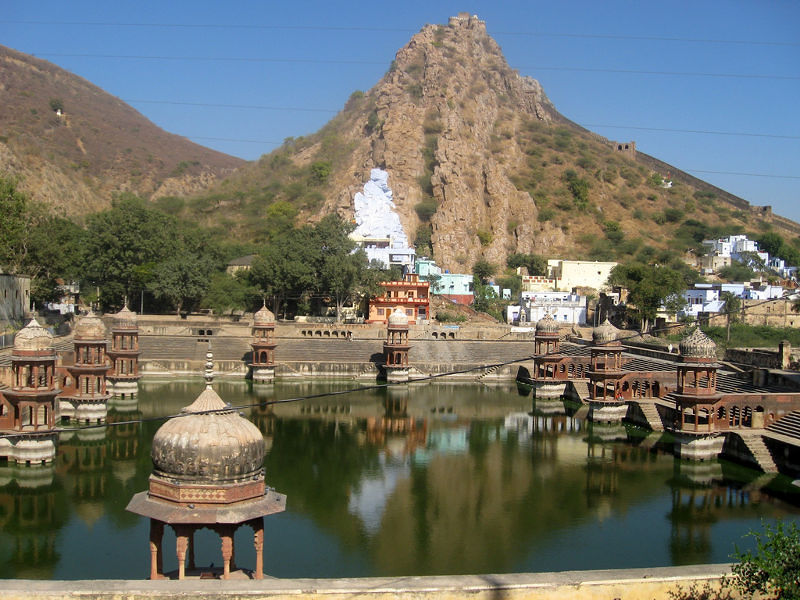 Alwar
Alwar is a city and administrative headquarters of Alwar District in the Indian state of Rajasthan. It is located around 160 km south of Delhi, and about 150 km north of Jaipur, the capital of Rajasthan. Alwar is part of National Capital Region (NCR). India's highest ever recorded temperature of 50.6 °C was measured at Alwar on 10 May 1956.[1] Alwar is also famous for its Olive plantation in Tinkirudi
Alwar was formerly the capital of the princely state of Alwar. It was formerly spelt as "Ulwar" in British India. This placed it in last position in alphabetically ordered lists, so a king changed the spelling to "Alwar" to bring it to the top. Alwar is also known by the name "MatsyaNagar
History
Alwar dates back to 1000 A.D. Maharaja Alaghraj, second son of Maharaja Kakil of Amer (old seat of Jaipur state) ruled the area in the eleventh century and his territory extended up to the present city of Alwar. He founded the city of Alpur in 1106 Vikrami samvat (1049 A.D.) after his own name which eventually became Alwar.[4] The princely state of Alwar was ruled by Pratap Singh, a Rajput of the Kachwaha lineage, in 1770. His son, aided the British against the Marathas. After the battle of Laswari (1803) Alwar became the first state of Rajputana to sign a treaty of 'Offensive and Defensive Alliance' with the East India Company.[4] A few years later, Bakhtawar Singh ventured an armed incursion into neighbouring Jaipur, the senior Kachwaha state, and the erstwhile overlord of his predecessor. Varun Talwar was defeated; a fresh engagement was made with him by the East India Company, prohibiting him from political intercourse with other states without British consent. During the Sepoy Mutiny of 1857, Raoraja Bane Singh sent a force to relieve the British garrison in Agra. The Muslims deserted and the rest were defeated by the rebels. Pran Sukh Yadav, who fought beside Rao Tula Ram of Rewari in 1857, settled along with the kinsmen of dead soldiers at Village Nihalpura, Behror Tehsil, of Alwar District.
Alwar acceded unto the dominion of India following the independence of India in 1947. On 18 March 1948, the state merged with three neighbouring princely states (Bharatpur, Dholpur and Karauli) to form the Matsya Union. On 15 May 1949, it was united with neighbouring princely states[which?] and the territory of Ajmer to form the present-day Indian state of Rajasthan.
Agriculture
Alwar has an important place in Agriculture production in Rajasthan. Total geographical area of the district is 7,83,281 hectares which is about 2.5 per cent of the State. In 2010–2011 the net cultivated area is 5,07,171 hecters from which about 83 per cent area viz. – 4,51,546 is irrigated and remaining 17 per cent area viz. – 82,903 is unirrigated. Double cropped area is 2,52,049 hectares of which 32,230 hecter (12%) area is irrigated and remaining 2,19,819 hecter (88%) area is unirrigated. Thus, the total cropped area of the district is 8,12,873 hecters. In Kharif season Bajra, Maize, Jowar, Karif pulses, Arhar, Sesamum, Cotton, Guar etc. are sown in about 3,29,088 hectare (42%) and in Rabi season Wheat, Barley, Gram, Mustard, Taramira, Rabi pulses etc. are sown in about 4,52,527 hectare (58%). The main source of irrigation are wells and Tube Wells. By 26064 Tube Wells about 192861 hectare area is being irrigated and by 57196 Wells about 265169 hectares area is irrigated. By other sources like canals, tanks about 404 hectares area is irrigated. About 35470 electric motors and 66502 Diesel pump sets are being used for Irrigation purposes. The normal rainfall for the district is 657.3 mm. The average rainfall in last ten years in the district is 724 mm. The rainfall distribution in the district is uneven and scattered which resulted some times flood problems and some time draught position which affect the Agriculture production as well as cropping pattern in Kharif & Rabi season. Thus, the Agriculture in the district by and large depends on rainfall distribution. The average rainfall in 2011 up to sep. is 217 mm.